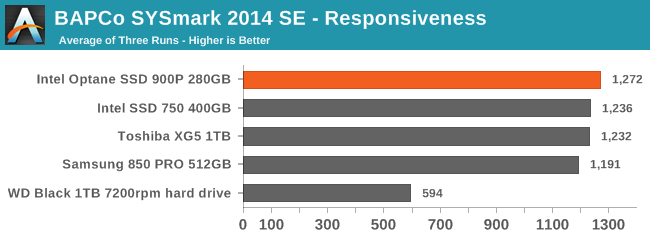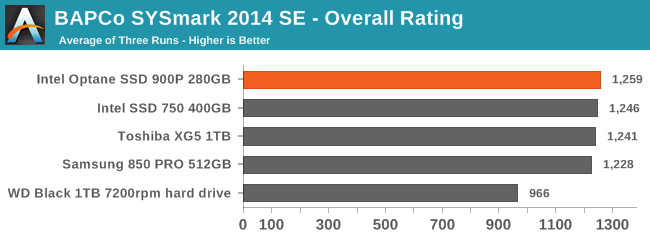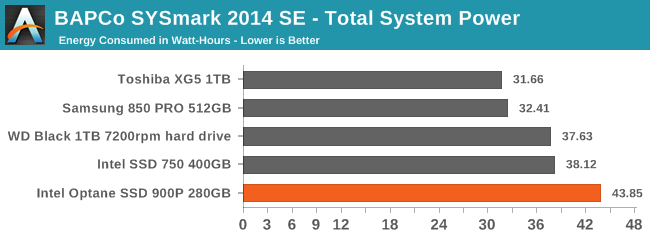The Intel Optane SSD 900P 280GB Review
by Billy Tallis on October 27, 2017 9:30 AM ESTBAPCo SYSmark 2014 SE
BAPCo's SYSmark 2014 SE is an application-based benchmark that uses real-world applications to replay usage patterns of business users in the areas of office productivity, media creation and data/financial analysis. In addition, it also addresses the responsiveness aspect which deals with user experience as related to application and file launches, multi-tasking etc. Scores are calibrated against a reference system that is defined to score 1000 in each of the scenarios. A score of, say, 2000, would imply that the system under test is twice as fast as the reference system.
SYSmark scores are based on total application response time as seen by the user, including not only storage latency but time spent by the processor. This means there's a limit to how much a storage improvement could possibly increase scores, because the SSD is only in use for a small fraction of the total test duration. This is a significant difference from our ATSB tests where only the storage portion of the workload is replicated and disk idle times are cut short to a maximum of 25ms.
| AnandTech SYSmark SSD Testbed | |
| CPU | Intel Core i5-7400 |
| Motherboard | ASUS B250-PLUS |
| Chipset | Intel B250 |
| Memory | 2x 8GB Kingston DDR4-2400 CL17 |
| Case | In Win C583 |
| Power Supply | Cooler Master G550M |
| OS | Windows 10 64-bit, version 1703 |
Our SSD testing with SYSmark uses a different test system than the rest of our SSD tests. This machine is set up to measure total system power consumption rather than just the drive's power.


SYSmark 2014 SE doesn't come close to stressing the storage system enough to show meaningful distinctions between high-end NVMe SSDs. The Responsiveness sub-test is the most sensitive to storage performance, and only shows a few percent difference between most SSDs. The overall test barely registers a difference at all. But with my primary power meter broken, SYSmark does provide a rough assessment of how power hungry the Intel Optane SSD 900P is:

The SYSmark energy usage scores measure total system power consumption, excluding the display. Our SYSmark test system idles at around 26 W and peaks at over 60 W measured at the wall during the benchmark run. SATA SSDs seldom exceed 5 W and idle at a fraction of a watt, and the SSDs spend most of the test idle.
Despite being the fastest drive in this bunch and thus the one with the shortest SYSmark run times, the Optane SSD 900P used far more energy over the course of the three SYSmark runs. With higher idle power than even the Intel SSD 750 and similar power draw under load, the Optane SSD 900P really needs its heatsink. Intel is a very long way off from being able to package this level of performance in a M.2 SSD.










205 Comments
View All Comments
lmcd - Friday, October 27, 2017 - link
Funny, when SSDs came out we were promised they'd be orders of magnitude faster than mechanical HDDs. The first ones weren't.Drumsticks - Sunday, October 29, 2017 - link
I think my primary point of criticism with your view is that, despite Intel not reaching their goals, it is measurably better than the competition at a better price per GB per performance.It might not have hit the endurance targets they wanted, but for 2-3x the cost of your opponent, they've achieved some 20x endurance, on par in the worst case, and 6-8 times better in many measurably important scenarios.
On top of that, you tout the benefits of SLC and claim that SLC is undeniably faster than XPoint, because if SLC wasn't held back by the cheap and underpowered controllers of yesteryear, it could really fly. How do you know the same thing is not true of 3DXP? Perhaps better understanding of its use and a better controller, and maybe a second generation of the memory, will enable Intel to reach even higher performance and endurance heights. You can't claim that SLC is better, and is simply held back by 2014 era controllers, while not allowing that 3DXP could likely be held back by it's controller as well. We have no idea what the performance ceiling for 3DXP is, because we've seen all of one generation of products.
To extend your analogy, I might be disappointed if I only received $450, but if everybody else is still only making $200, I'm going to go home happy.
Rektide - Friday, October 27, 2017 - link
This shows an Intel 900P with a total write endurance of 8.7PB, and a 850 Pro with a total write endurance of 150 TB. But a stress test of a 850 Pro in fact survived 9.1 PB[1]! Meanwhile, if you reach 8.7PB on the 900P, Intel will forcibly move your drive into read-only mode.If you look at Ark, Intel describes it's Endurance Rating to mean "Endurance rating indicates the expected data storage cycles to be expected over the life of the device." When they say that, they mean "and not a megabyte more". Whereas when Samsung says it, they, at least once, meant "but this drive may go 60x more than it's rating". I really severely dislike this twist of the knife, this drastic change Intel and Intel alone is perpetrating against it's consumers.
Does the P4800X also commit seppuku the megabyte it reaches it's Endurance Lifetime? I'm not sure if all Intel drives are so malicious, or is it consumer & enthusiast drives? How do I know which drives are programmed to self destruct on me, Intel?
[1] http://www.guru3d.com/news-story/endurance-test-of...
ddriver - Friday, October 27, 2017 - link
It is actually worse than locking in read-only mode - on the next boot cycle the drive gets bricked. So if you didn't manage to get that data in time, it is gone forever. Great feature.Spunjji - Saturday, October 28, 2017 - link
I have seen this with Intel consumer SSDs. It's amazing - it doesn't even tell you that it's failing and that you have one (yes, one) chance to backup your data before it goes forever. Usually the drive just throws an error, so your average user reboots the system and bam, the drive's not even in the BIOS anymore.Their drive failure behaviour is criminal.
voicequal - Saturday, October 28, 2017 - link
Agreed - bricking is a terrible failure mode for a consumer drive. For an enterprise drive, it *might* make sense, since its you want things to fail hard and fast so that backup systems can detect and take over.FwFred - Friday, October 27, 2017 - link
Wow, need a block button to improve SnR.Meteor2 - Tuesday, October 31, 2017 - link
Indeed -- though I simply skip any comments written by ddriver. Never any value in them (but a remarkably effective troll).Lolimaster - Saturday, October 28, 2017 - link
The 1000X was supposed to be on latency and endurance, not much more, and maybe 10X random 4K performance.CajunArson - Friday, October 27, 2017 - link
I thought you were a reliable AMD koolaid drinker?It's funny how you insult these products that you have never used but would never in a million years hurl their $7000 Radeon SSG under the bus... you know, the one that uses a consumer-grade GPU slapped together with a RAID-0 array of cheap consumer-grade NVME drives to supposedly do rendering jobs faster than a regular GPU.